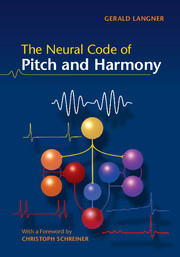Book contents
- Frontmatter
- Contents
- Preface
- Foreword
- 1 Historical aspects of harmony
- 2 Sound and periodicity
- 3 The discovery of the missing fundamental
- 4 The pitch puzzle
- 5 The auditory time constant
- 6 Pathways of hearing
- 7 Periodicity coding in the brainstem
- 8 Periodicity coding in the midbrain
- 9 Theories of periodicity coding
- 10 Periodotopy
- 11 The neural code of harmony
- 12 The oscillating brain
- References
- Index
8 - Periodicity coding in the midbrain
Published online by Cambridge University Press: 05 May 2015
- Frontmatter
- Contents
- Preface
- Foreword
- 1 Historical aspects of harmony
- 2 Sound and periodicity
- 3 The discovery of the missing fundamental
- 4 The pitch puzzle
- 5 The auditory time constant
- 6 Pathways of hearing
- 7 Periodicity coding in the brainstem
- 8 Periodicity coding in the midbrain
- 9 Theories of periodicity coding
- 10 Periodotopy
- 11 The neural code of harmony
- 12 The oscillating brain
- References
- Index
Summary
Coding of complex sounds
Processing of species-specific vocalizations
In the early 1970s, the customary silence of the green woods surrounding the MaxPlanck Institute for Biophysical Chemistry in Göttingen-Nikolausberg was disturbed by harsh animal cries. The strange grating sounds emanated from a hutch on the roof of one of the ivory towers of this renowned institute. Underneath, seemingly oblivious to the cacophony overhead, scientists in Professor Otto Creutzfeldt's neurophysiology department were busy investigating how the brain perceives and analyses olfactory, somato sensory, visual and auditory information. The hutch that was the source of these unusual cries housed helmeted guinea fowl (Fig. 8.1), the subjects of neurophysiologic research for a team of four young scientists, Vreni Maier, Henning Schiech, Rainer Koch and myself, who were fascinated by their vocalizations.
We selected these long-necked relatives of pheasants for our research because we wanted to investigate the processing of species-specific vocalizations in their central auditory system. Our working hypothesis was that recognition of complex communication sounds might involve feature detectors, i.e. neurons which respond preferentially, if not exclusively, to particular combinations of acoustic parameters characteristic for these sounds.
As our investigations revealed (Maier, 1982; Scheich et al., 1983), besides formants comparable to those in human vowels, another important feature of guinea fowl communication sounds is periodic amplitude modulation (AM) (Fig. 8.2). As harmony, formant structure and more or less rapid AMs are characteristic of many communication sounds, the neuronal coding of guinea fowl communication is an excellent model for auditory coding mechanisms in general, including human speech processing.
For our experiments we selected the auditory midbrain nucleus MLD (mesencephalicus lateralis, pars dorsalis), which in birds corresponds to the mammalian inferior colliculus. Our aim was to record from single neurons in the midbrain while the birds were sitting in a soundproof booth, listening to a tape recording of species-specific vocalizations.
- Type
- Chapter
- Information
- The Neural Code of Pitch and Harmony , pp. 105 - 121Publisher: Cambridge University PressPrint publication year: 2015



